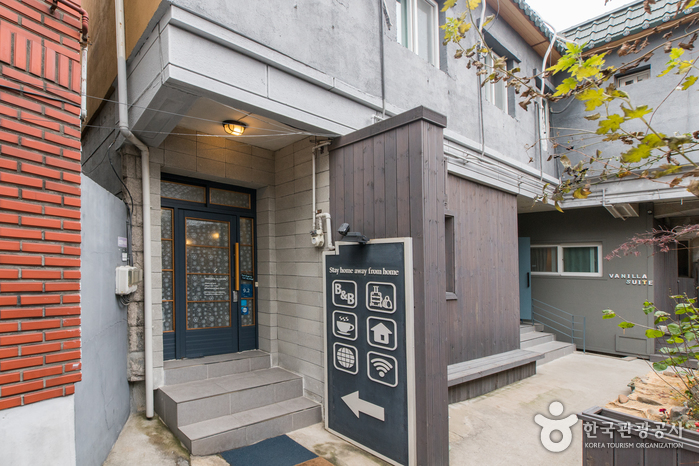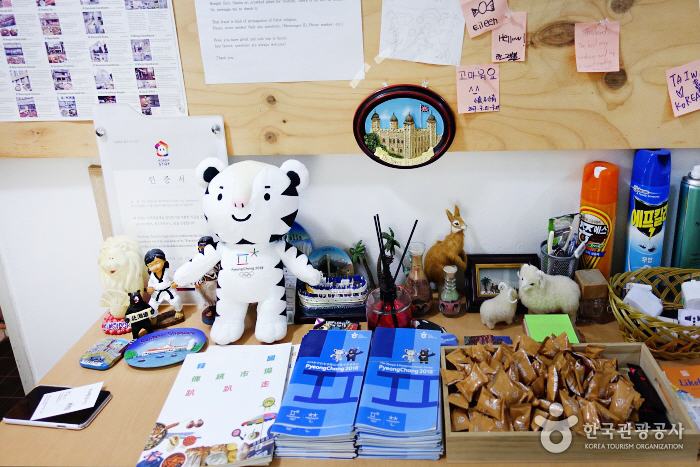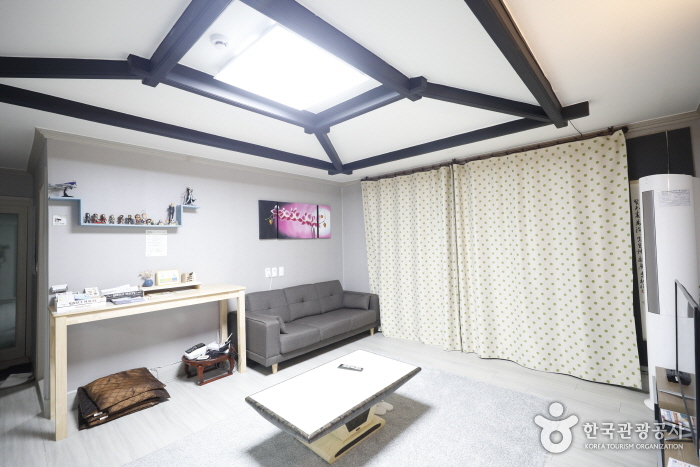Sane Flower [Korea Quality] / (주)산에는 꽃이피네 [한국관광 품질인증]
2020-09-03
20-1, Dongnyeok-gil, Dado-myeon, Naju-si, Jeollanam-do
+82-10-4612-4232
‘Flowers Blossoms in the Mountains’ is a hanok-style accommodation located between the House of Hong Gi-chang, a local cultural heritage, and Gyeeun Historic House (or the House of Hong Gi-eung; National Folklore Cultural Heritage No. 151) in Dorae Hanok Village. Built in 1917, the house was built with carefully selected high-quality wooden materials without using nails. It was renovated for use as tourist accommodation in 2011, opened as a hanok style of accommodation in 2013, and renovated again in 2014. On this occasion, the old doors were replaced and made into the tables that stand in the grassy courtyard.
The house has a total of 4 rooms. Each room can accommodate up to 2 to 4 people. Each room is equipped with a kitchen, bathroom, air-conditioner, TV, toiletries, plates, and so on.
This well-insulated hanok house is decorated with hanji (traditional Korean paper handmade from mulberry tree) and various antique items. Tables are available for guests in the courtyard, of which a stylish stone-paved corner stands out in particular.
There is a walkway established by Naju City in front of the house, and a vegetable garden near the house. Guests can see gourds and sponge gourds in the yard and acorn trees on the hill behind the house. In addition, the Metasequoia Street that runs through the grounds of the Naju Forest Resource Institute is just one minute’s drive from the house.
Moreover, as the village contains many houses that are classed as cultural heritages, the owner guides guests around them at weekends. Surrounding tourist attractions include Bulhoesa Temple and Najuhyanggyo Confucian School.
Eoryeondang [Korea Quality] / 어련당 [한국관광 품질인증]
2020-12-12
61, Sanjeon-gil, Jung-gu, Ulsan
+82-52-297-5796
Located in Jung-gu, Ulsan City and built and operated by Jung-gu Office, Eoryeondan Guesthouse was opened in August 2014 to offer guests an opportunity to enjoy a hanok stay and various traditional Korean experiences. The house was named ‘Eoryeondang,’ meaning a “house abounding with beautiful words,” after Eoryeoncheon Stream (previously Dongcheon Stream).’ This two-story hanok building was built with granite construction materials including the staircases, fence, and external pillars, creating a solid and majestic impression. Located next to the house is Sanjeonsaem Spring, which was found over 400 years ago and used to supply the house with drinking water, but it was transformed into a garden after the spring ran dry. Eoryeondang has seven guestrooms all together, including three rooms (26m2) equipped with a sink, another three rooms (26m2 each) without a sink, and one room (about 39㎡) equipped with a maru (wooden floor). In particular, the large room, Eoryeonjae, is recommended for family guests. Six of the rooms - Yi, Ho, Ye, Byeong, Hyeong and Gong - were named after administrative agencies of the Joseon Dynasty. Each room can accommodate from 4 to 6 people and is equipped with a bathroom, TV, air-conditioner, refrigerator, Wi-Fi, etc. Set amid an attractive natural environment including pine and bamboo trees, the house is characterized by its interesting ceilings, including the ‘井’-shaped ceiling on the first floor, and the exposed rafters on the second floor. The house is mainly built of pine wood, and each room is decorated with a traditional style of floor paper using beans and hanji (traditional Korean paper handmade from mulberry tree) wallpaper. The house is adjacent to various interesting sites including the Military Headquarters of Gyeongsangjwa-do Province (Historic Site No. 320), where the military governor of Gyeongsangjwa-do used to stay; an elliptical fortress built in 1417, with a circumference of 1.2km and walls about 3.7meters high; Oesol Memorial Hall, which is a Hangeul museum; and Dongcheon Water Park. It also offers guests the opportunity to play various folk games including yut (a Korean traditional board game), tuho (stick throwing), jegichagi (Korean shuttlecock game). The house makes continuous efforts to improve its services by surveying its guests and reflecting their opinions accordingly.
Hostel Vanilla2
2021-04-09
34-8, Jong-ro 57-gil, Jongno-gu, Seoul
+82-10-9945-1944
Hostel Vanilla 2 is a guesthouse in a residential house located in Sungin-dong, Jongno-gu, Seoul. The 2-story house has 9 cozy rooms. Over 90% of the guests are from China, Taiwan, Hong Kong, Thailand, and Japan, and most of them are in their twenties. Since it is within a 10-minute walk from Dongdaemun Design Plaza, most guests – particularly those who came to Korea to shop during their tour - stay there for three or four days. All the guestrooms are for two and are kept clean at all times. The guesthouse provides free luggage storage service even after the guest has checked out, which is very convenient to the shoppers. Because the guests are young, the guesthouse owner communicates with the guests through various social network services and apps.
The House of Yehbon [Korea Quality] / 예본의 집 [한국관광 품질인증]
2020-09-03
1 FL, 64, Gaepo-ro 118-gil, Gangnam-gu, Seoul
+82-10-3908-1617, I have a what's app.
The house of Yehbon(예본의 집) is a guesthouse in a single-story residential house. The owner of the guesthouse has stayed at many guesthouses in the US while traveling and loved how they decorated the rooms according to the unique characteristics of the region. This is why she furnished the rooms with a traditional Korean cabinet inlaid with mother-of-pearl and other furniture that are more than 100 years old and covered with mantles that she herself embroidered. The antique furniture is one of the outstanding features of this guesthouse, which has two guestrooms, living room, kitchen, and two bathrooms. Many guests are from India, Canada, America, Netherlands, and Russia, including Koreans living abroad, and they say they find this place very comfortable. It's like homestay, but the owner of the guesthouse tries to provide enough privacy for those who wish to be left alone as well. It’s very conveniently located in Gangnam with access to public transportation within the vicinity and close to the subway station(3rd Daecheong station).
I give my guests space but I am available when needed. Privacy is protected. You can always communicate with the host. The guests stay in the 1st floor, and the host lives in the 2nd floor. You can cook and enjoy a meal together in a spacious kitchen. You can take a shower but no bathtub in the bathrooms. It's very easy to find my place. Parking: Just next to the gate. (20 steps) There're a lot of delicious inexpensive restaurants and a CU convenience store just in front of the house.
Seoul Naksan Stay [Korea Quality] / 서울 낙산 스테이 [한국관광 품질인증]
2023-04-13
Samseongyo-ro 4-gil, Seongbuk-gu, Seoul
Seoul Naksan Stay is a guesthouse in a downtown area. The owner, who originally ran a guesthouse in Yongin, Gyeonggi-do, opened this guesthouse after moving to Seoul. Naksan Stay is located at the low end of the fortress wall of Naksan Park, which is a great place to enjoy the night view of Seoul. The guesthouse has two gates: one leading to the small building where the owner and her family reside, and the other one leading to a bigger building that serves as a guesthouse with a spacious two-story room. Majority of the guests are from France and Russia. It’s a great place to stay for those wishing to enjoy the daytime and nighttime views of the city.
Moonguesthouse [Korea Quality] / 문게스트하우스 [한국관광 품질인증]
2020-09-09
31-18, Samil-daero 32-gil, Jongno-gu, Seoul
+82-2-745-8008, +82-10-8704-9981
The Moon Guesthouse is situated near a number of interesting tourist destinations including Unhyeongung Palace (3min on foot), Bukchon Hanok Village (5min on foot), Changdeokgung Palace (5min on foot), and Changgyeonggung Palace (10min on foot). The guesthouse was named ‘moon’ (‘door’ in English) because it has many 176 doors and windows. Upon entering by the gate, visitors will see a ‘ㄷ’-shaped hanok building in the courtyard, in which a wooden bedstead and a table are placed. On the opposite of the hanok building there is a wall roofed with tiles engraved with Korean patterns such as deer, pine, turtle, etc. Flowers in the flowerbed lined up along the wall are in bloom and the bonsai are also well-kept in the house. Renovated and opened as a guesthouse in September 2011, Moon Guesthouse consists of a bonchae (main building) and a byeolchae (detached house). The rooms are decorated with red clay and hanji (traditional Korean paper handmade from mulberry trees), and have under-the-floor heating (ondol). Each room is equipped with an air-conditioner, and has a 40cm-thick layer of red clay over the ceiling for insulation, making the rooms cool in summer and warm in winter. The house has seven individual guestrooms and five modern bathrooms, but the entire building (bonchae or byeolchae) can be rented, too. In particular, the unhyeondang of the bonchae is very popular as it can be converted into one large space for special events, group workshops, etc. simply by opening all the sliding doors (Bunhapmun – Goryeo construction style). This room, which is decorated with a flower-patterned windscreen, a landscape painting, and calligraphy, has been used as a shooting location for various TV programs including KBS2’s TV reality program Man’s Qualification and its variety show The Human Condition. The guestrooms are also equipped with traditional furniture including a cabinet inlaid with mother-of-pearl. The guesthouse also provides a variety of experience programs from 11am to 3pm, including tea ceremony, wearing Hanbok (traditional Korean clothes), making kimchi and gochujang (red chili paste), playing a traditional musical instrument, making a rubbing of a stone inscription, calligraphy, drawing orchids on a fan, and so on. The house has about seventy hanbok and other clothing accessories, as well as a royal costume. Its calligraphy and drawing orchid programs are run directly by the owner, who used to work as a classical Chinese teacher at a high school.
LikeU (라이크유)
2025-06-18
53, Wausan-ro 35-gil, Mapo-gu, Seoul
LikeU is a guesthouse in Seogyo-dong, Mapo-gu, Seoul, one of the downtown areas of Seoul that’s popular among young people. It's within a 2-minute walk from Hongik Univ. Station on Subway Line 2. For this reason, majority of the guests are young people from Hong Kong and Singapore. The owner of the guesthouse goes the extra mile to make sure that the rooms, beds, sheets, and blankets are clean, so the minimum length of stay is 3 days. All the guestrooms are two-story rooms for more space. There is a washing machine in each of the rooms for the convenience of the guests. Use of the washing machine is free.
Central Park Hotel [Korea Quality] / 센트럴파크 호텔 [한국관광 품질인증]
2025-01-02
20, Haegwan-ro, Jung-gu, Busan
+82-51-243-8001
Central Park Hotel is located in the middle of Jungang Station and Nampo Station on Busan Metro Line 1. It’s a 15-story building with a total of 67 rooms in different sizes, and some of the rooms have a view of the ocean. The cafeteria serving breakfast is a few steps up from the first floor. There is an indoor terrace right next to the elevator with a table next to the window, and it's free to use for all the guests. The hotel has a parking tower for the guests to park. The lobby is open 24 hours with staff to provide services, with maps and booklets for tourists. The hotel offers luggage storage service for guests who have arrived before the check-in hour or who plan to stay in the area after the check-out hour. Nearby tourist destinations include Yongdusan Park, Gwangbokro Fashion Street, Changseondong Meokja Golmok, Bupyeong Jokbal Golmok, and BIFF. It's easy to get to the downtown area from the hotel.
The Park Guesthouse (더파크 게스트하우스)
2025-06-04
151, Gwangnam-ro, Suyeong-gu, Busan
The Park Guesthouse is an affordable homestay in the Gwangalli Beach area of downtown Busan, where guests will meet tourists from many other countries. Accomodation consists of bedrooms with toilets plus a large shared living room with kitchen, bathroom. and laundry facilities. The kitchen is adequate for basic cooking. The guesthouse is not far from Gwangan subway station, and Gwangalli Seafood, Busan Millak Sashimi Restaurant Street, and Pojangmacha Street are all close by.
Gyeongjuhanok 1st [Korea Quality] / 경주 한옥 1번가 [한국관광 품질인증]
2021-04-05
20, Cheonwon 1-gil, Gyeongju-si, Gyeongsangbuk-do
010-9505-5367
As a new hanok guesthouse, Gyeongju Hanok 1st is located at the entrance to Cheonwon Village, Gyeongju, Gyeongsangbuk-do. It has various modern amenities while preserving the features of a traditional Korean house. The guesthouse is kept cool in summer and warm in winter, so guests can experience the traditional Korean house. It has various rooms in different sizes that can accommodate 3 - 8 people. There is a stand-alone guesthouse furnished with kitchen and bathroom as well. All other rooms also have a bathroom inside, but the kitchen must be shared among the guests. There are no beds in the room as is typical of a traditional Korean house, but there are high-quality sheets and blankets for the comfort of the guests. The guesthouse has a large front yard with a miniature traditional Korean house with dolls adorned in traditional clothes, not to mention other traditional artifacts. Popular tourist destinations within the vicinity of the guesthouse include Anapji Pond, Cheomseongdae, and Gyeongju National Museum.
![Sane Flower [Korea Quality] / (주)산에는 꽃이피네 [한국관광 품질인증]](http://tong.visitkorea.or.kr/cms/resource/98/2574998_image2_1.jpg)
![Eoryeondang [Korea Quality] / 어련당 [한국관광 품질인증]](http://tong.visitkorea.or.kr/cms/resource/85/2050185_image2_1.jpg)

![The House of Yehbon [Korea Quality] / 예본의 집 [한국관광 품질인증]](http://tong.visitkorea.or.kr/cms/resource/08/2557408_image2_1.jpg)
![Seoul Naksan Stay [Korea Quality] / 서울 낙산 스테이 [한국관광 품질인증]](http://tong.visitkorea.or.kr/cms/resource/00/2574600_image2_1.jpg)
![Moonguesthouse [Korea Quality] / 문게스트하우스 [한국관광 품질인증]](http://tong.visitkorea.or.kr/cms/resource/09/2577509_image2_1.jpg)

![Central Park Hotel [Korea Quality] / 센트럴파크 호텔 [한국관광 품질인증]](http://tong.visitkorea.or.kr/cms/resource/77/2669477_image2_1.jpg)

![Gyeongjuhanok 1st [Korea Quality] / 경주 한옥 1번가 [한국관광 품질인증]](http://tong.visitkorea.or.kr/cms/resource/10/2530210_image2_1.jpg)
 Español
Español
 한국어
한국어 English
English 日本語
日本語 中文(简体)
中文(简体) Deutsch
Deutsch Français
Français Русский
Русский